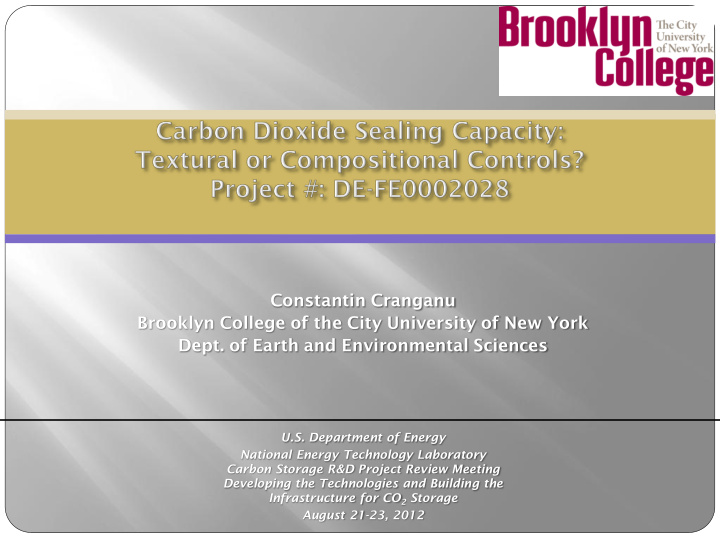



Constantin Cranganu Brooklyn College of the City University of New York Dept. of Earth and Environmental Sciences U.S. Department of Energy National Energy Technology Laboratory Carbon Storage R&D Project Review Meeting Developing the Technologies and Building the Infrastructure for CO 2 Storage August 21-23, 2012
Benefits of the program Project Overview: Goals and Objectives Technical Status Accomplishments to Date Summary – Key Findings Summary – Lessons Learned Summary – Future Plans Appendix
The Program goal being addressed: Develop technologies to demonstrate that 99 percent of injected CO 2 remains in the injection zones. The research project is investigating the role of compositional and structural properties of caprock on sealing capacity of a CO 2 sequestration site. The research, when finished, will advance our knowledge of the sealing capacity of rocks such as shales and anhydrites and, in turn, will provide a better understanding of the processes that take place in geologic reservoirs that are subject to CO 2 injection. This research contributes to the Carbon Storage Program’s effort of ensuring 99% CO 2 storage permanence in the sequestration zones.
Major Objective The major objective of this research is to test whether textural parameters (e.g., the pore ‐ throat size, distribution, geometry, and sorting, grain size, etc.) or compositional parameters (e.g., compaction, mineralogical content, cementation, organic matter content, carbonate content, etc.) of cap rocks control their CO 2 sealing capacity.
Advancing scientific discovery and understanding through proposed activity that will be intimately related to promoting teaching, training and learning activities at Brooklyn College. I teach an upper tier core course, titled “Climate Change – Torn between Myth and Fact” . During course lectures and practice activities, undergraduate students from various departments will learn about the most important environmental issues raised by increased concentration of CO 2 in the atmosphere and the efforts taken by many countries, including USA, to reduce the amount of CO 2 . One of the efforts, namely carbon dioxide sequestration, will be exemplified by our anticipated results.
Students get trained in incorporating new data from our database in existing databases that will be provided to them during the course and practice activities.
From Puckette, 2006
From Puckette, 2006
Sample #601-6 (Depth 3,847-3,850 ft) Gray Limestone (Fine – Medium Grain)
Sample #601-6 (Depth 3,847-3,850 ft) Gray Limestone (Fine – Medium Grain) EDS analysis indicating the SEM microphotograph . Calcite predominance of Ca. An XRD analysis crystals are abundant. Intercrystalline indicates 96.7% calcite porosity
Mercury Intrusion Porosimetry Measurements Sample #601-6
Surface Area Measurements Sample #601-6
Grain Size Measurements Sample #601-6
XRD Measurements Sample #601-6
Source-Rock Analysis and Total Organic Carbon Job Number: 110558G Total Organic Carbon Vs. Depth Oil Potential, S2 Vs. Depth TOC S2 Depth (ft) Depth (ft) 0 0 500 500 1000 1000 1500 1500 2000 2000 2500 2500 3000 3000 3500 3500 4000 4000 4500 4500 Poor Poor Fai Fair Good Excellent Good - Excellent 5000 5000 0 2 4 6 8 10 12 0 5 10 15 20 25 30 35 40 S2 (mg HC/g) Total Organic Carbon wt% HC (TOC)
Source-Rock Analysis and Total Organic Carbon
30 samples of caprock from three depleted gas fields in Oklahoma Panhandle have been collected. For each sample the following measurements have been performed: Mercury Intrusion Porosimetry SEM microphotography EDS analysis Surface area Grain size Source rock analysis and Total Organic Carbon XRD Lithological descriptions
We estimated the sealing capacity of caprocks in the Oklahoma Panhandle in terms of CO 2 column height that can be held back by a given seal. The range of CO 2 column height for the samples used in this research is between 2 ft – 3,596 ft (0.6 – 1,096 m) The average CO 2 column height is 945 ft (291 m) The depth interval between approximately 3,500 – 5,500 ft exhibits the largest values of CO 2 column height. The above mentioned interval is comprised of mainly Cherokee and Morrowan formations (shale seals).
The distribution of CO 2 column height value with sample depth
The students learned how to organize research, from developing research questions to crafting a proposal, to working with scientific literature, to designing the research plan. The students applied a potential method for learning and exploring a topic of interest, like carbon dioxide sequestration as a way of mitigating the current global warming trend. The students learned that responsibility and integrity in the research program are essential components of their process of becoming future scientists.
We are planning to incorporate permeability measurements (both absolute and relative) as a new structural/compositional variable in our model of caprock sealing capacity. We will run sensitivity test to estimate the importance of other parameters on CO 2 column height: contact angle CO 2 /brine (0 , 10 , 20 , or 60 ) pressure at sample depth temperature at sample depth brine concentration at sample depth CO 2 density brine density interfacial tension
PI: Prof. Constantin Cranganu Sadiqua Azad, PhD student Kieva Watson, Undergraduate student With over 16,000 students, Brooklyn College has an impressive racial, ethnic, religious, and minority diversity. From its founding seventy-six years ago, the College has offered men and women – immigrants or the children of immigrants, often the first in their families to go to college – the opportunity to receive a first-rate education that leads to productive careers and satisfying lives. As researchers and educators at Brooklyn College, we are committed to broaden opportunities and enable participation of all students in research projects, as an essential way to maintain the health and vitality of science and engineering.
Puckette, J., 2006, Naturally Underpressured Compartments And the Geologic Sequestration of Carbon Dioxide, http://www.searchanddiscovery.com/documents/2006/ 06088houston_abs/abstracts/puckette.htm?q=%2BtextStr ip%3Apuckette
Recommend
More recommend